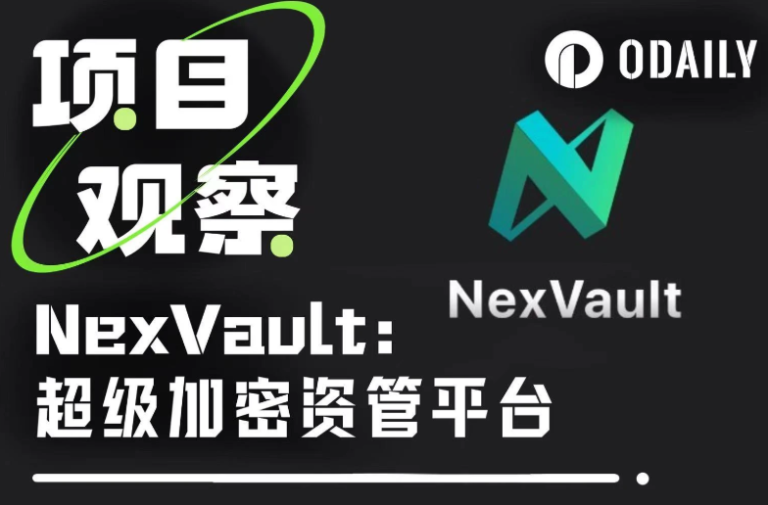
From Stablecoin Regulation to Asset Inheritance: How NexVault is Reshaping Crypto Asset Management
Two recent events in the crypto world have sparked discussions: On June 18, the U.S. Senate passed the “GENIUS Act,” setting the tone for stablecoin regulation and accelerating crypto mainstream adoption. The next day, Binance founder CZ called for platforms to introduce a “will function” to address asset distribution after users pass away. Though seemingly unrelated, these events point to a core need: crypto asset custody. Unlike traditional asset management with multi-trillion-dollar markets, crypto asset management remains an untapped “virgin land,” with urgent demand for reliable custody solutions from institutional entry, family inheritance, high-frequency trading, and other scenarios.
Just in time, the Web3.0 Cryptocurrency Exchange Security Risk Guide has brought NexVault into the spotlight. This enterprise-level crypto asset self-custody platform manages over $2 billion in assets, serving exchanges, funds, family offices, quant firms, and high-net-worth individuals, opening new possibilities for the industry with a “zero asset loss” record.
The “Doomsday” Year for Crypto Security: $2 Billion in Losses Force Custody Upgrades
This year’s crypto security incidents have been nothing short of “epic failures”: Bybit lost $1.5 billion to hackers, Infini was defrauded of $50 million by an insider, and SUI ecosystem protocol Cetus suffered $60 million in losses… Risks now go beyond phishing and on-chain poisoning to include “hybrid threats” like traditional asset conversion vulnerabilities, insider threats, and ecosystem coordination risks.
The data is even more alarming: As of April 2025, crypto hacking losses reached $1.74 billion, exceeding 2024’s full-year total of $1.49 billion. May alone saw $244 million lost in 20 major incidents, pushing the year-to-date total near $2 billion. Whether traditional institutions, crypto exchanges, family offices, or quant teams, all亟需 a new asset management solution that is “secure, efficient, and trustworthy”. NexVault was built for this moment.
NexVault: More Than a Wallet, the Next-Gen Crypto “Vault Standard”
“NexVault = Next (the next generation) + Vault (the treasury). We aim to do more than just a self-custody wallet—we’re redefining crypto asset management standards,” team members explain the brand positioning. This means upgrading the entire chain from asset storage and security management to inheritance planning and enterprise risk control.
Hardcore Team Endorsement: Trillion-Dollar Asset Managers at the Helm
Maintaining a “zero asset loss” record in the high-risk crypto industry wouldn’t be possible without a top-tier team:
– Founder L14ng: Former Vice President of Security at Huobi, once managed hundreds of billions in USD crypto assets, with expertise in cold/hot wallet and exchange security architecture;
– CSO Rick Chen: Veteran crypto security expert focused on cross-chain risk control and enterprise compliance strategies.
The team collectively boasts over a decade of experience in crypto security and system architecture, safeguarding $2 billion in managed assets.
Tackling 3 Industry Pain Points
NexVault targets the biggest current asset management headaches:
– Enterprise-level: Lengthy processes, complex operations, and multiple weak links;
– Institutions/Families: Concentration of large-scale assets in a single wallet, high risk concentration;
– Quant/Individuals: Frequent on-chain operations with poor traceability and messy permission management.
It offers not just a tool, but a “rule-based governance” system—making on-chain assets as secure, orderly, and controllable as bank accounts, moving beyond the粗放 “human-dependent” model of the past.
4 Key “Weapons”: Custom Solutions for All Scenarios
NexVault’s $2 billion in managed assets come from four main client types, each with tailored solutions:
1. Enterprise Crypto Wallet (Top Choice for 40% of Institutional/Fund Clients)
Designed for exchanges, investment institutions, and market makers, focusing on “lowering barriers, boosting efficiency, and enhancing security.” Supports multi-role permission control, fund approval workflows, signature security management, fund isolation by organization, and even custom tagging for clear financial operations.
2. Enterprise Cold Wallet (The “Ultimate Safe” for Assets)
Like an enterprise’s “underground vault”: Mnemonics generated locally, transactions signed offline, never touching the internet. Combined with multi-signature and permission approval, it maximizes asset security.
3. Family Crypto Asset Wallet (A Must for 30% of Family Offices/High-Net-Worth Individuals)
Solving the “heirloom” problem: Mnemonic self-custody + family joint management + intergenerational inheritance. Supports multiple backups, preset heirs and inheritance processes, and manages on-chain asset allocation and returns, allowing wealth to pass through time.
4. One-Stop Trading Management (Essential for 20% of Quant Teams)
Tailored for asset managers and quant traders, focusing on risk control and efficiency. Supports risk exposure monitoring, one-click sub-accounting, transaction drawdown analysis, TEE secure storage for auditable transaction data, and unified management of multi-platform assets and P&L—keeping even high-frequency operations organized.
Cross-Chain & Cross-Platform Integration + Multiple Security Layers
NexVault already supports native multi-signature on 13 major blockchains (Bitcoin, Ethereum, Solana, etc.) and integrates assets from platforms like Binance and OKX, providing a global asset overview. Security is “layered up”:
– Core modules audited by SlowMist and other firms;
– Full-link audit records + signature traceability;
– Custom solutions for enterprise/high-net-worth clients;
– Emergency freeze and recovery mechanisms for extreme cases, eliminating permanent asset loss.
“Our goal is: When the unexpected happens, client funds remain trustworthy,” emphasizes CSO Rick Chen.
Future Plans: From Web3 to Web2, AI-Powered Asset Management
NexVault is rapidly expanding globally, focusing on regions with concentrated high-net-worth individuals and institutions: Hong Kong (China), Japan, South Korea, Southeast Asia, Europe, and the U.S. Next steps include integrating traditional financial systems (e.g., ERP, family office tools) and introducing AI/AI Agents for autonomous asset management, enhancing flexibility while maintaining security.
From July 2-4, NexVault will attend IVS Crypto 2025 in Tokyo, Japan, where it will announce more feature updates and roadmap details—stay tuned.
Conclusion: The Asset Management “Bridge” Between Web2 and Web3
The biggest barrier to crypto mainstream adoption is the lack of unified account management, permission boundaries, and private infrastructure. NexVault’s mission is to bridge the gap between Web2 and Web3 asset management, connecting on-chain/off-chain and freedom/compliance.
Finally, NexVault’s advice for three user groups:
– Institutions: Don’t treat “signing” as a simple technical action—it’s the cornerstone of your asset workflow management;
– Family Offices: Inheritance isn’t about post-crisis fixes—it should be planned today and validated tomorrow;
– Quant Traders: Always assume “being scammed by your own team once”—your risk control and exit mechanisms must withstand that hit.
STAY SAFE.
(NexVault Official Website Interface Schematic)
Read More《NexVault:开启企业级自托管资管平台新境界》
This content is AI-generated and does not constitute investment advice. Please exercise your own rational judgment.
More
Chain Exploration”Exploring Sahara AI: A Comprehensive Guide to SAHARA Tokens”
Chain Exploration”Which Web2 businesses are more suitable for quickly introducing stablecoins?”
Latest
- Startup Commentary”The Incomplete Evolution History of Bathing Centers”
- Startup Commentary”Starting from 358,800 yuan, Maserati Slashes Prices Drastically to Survive”
- Startup Commentary”Monopoly: Always the Best Business”
- Startup Commentary”A PE Giant Spent $6.6 Billion on a Crematorium”
- Startup Commentary”In a Low-Sports Year, Social Assets Still Hold Great Value”





